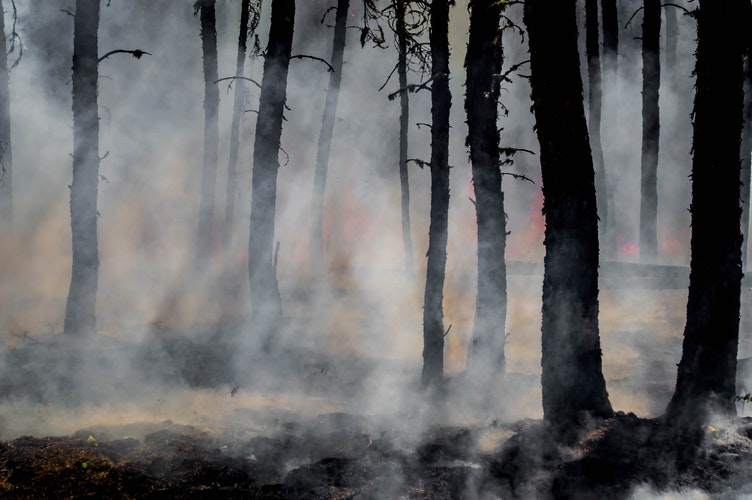The Uninhabitable Earth tackles big crises and solutions. But we should also sweat the small stuff.
Forest fires are one in a long list of vividly detailed, harrowing climate change effects that David Wallace-Wells describes in his new book. By 2040, it is likely that the areas affected by wildfire in the US will quadruple. Photo source
Heat Death, Hunger, Unbreathable Air. The chapter titles in David Wallace-Wells’s new book on climate change don’t beat around the burning bush. Like harrowing pronouncements by a prophet of old, the book paints an apocalyptic picture of our world, warmed.
It warns that when we reach 1.5°C of warming above pre-industrial levels (which will almost certainly happen by 2040), nearly all coral reefs will be dead, American wildfire areas could quadruple, and extreme high temperatures could double globally. At 2°C (practically inevitable by the end of this century), ice sheet collapse will flood coastal cities like Miami and Hong Kong, and major cities in India will experience lethal heat, becoming essentially uninhabitable. At 3°C, Southern Europe will be in permanent drought. At 4°C, global grain yields could fall by 50 percent. At 8°C, humans in the tropics would not be able to move around outside without dying.
In our climate-ravaged future, fire and brimstone won’t be an exaggeration. Climate science is fearsome.
“Like harrowing pronouncements by a prophet of old, the book paints an apocalyptic picture of our world, warmed. ”
Wallace-Wells’s cautionary prophetic vision calls to mind sci-fi thrillers like The Day After Tomorrow or Snowpiercer, but without the scientific inaccuracy and comfort of a fictional lens. New Yorker writer Rachel Riederer recalls her heart racing and eyes welling up as she read Wallace-Wells’s escalating disaster timelines, tracking them with her own future life stages and those of her potential children. Conveying in precise, systematic detail the magnitude of the coming crisis is one of the book’s primary aims and achievements. In fact, it most immediately reminded me of The Big One, a podcast about the impending 7.8 magnitude earthquake in Southern California, which draws listeners in by narrating in morbid detail the potential scenarios in which everyday lives will be thrown into crisis at the whim of Mother Nature. The central difference, of course, is that the climate catastrophe is driven by whims entirely human.
When the Earth reaches 2°C of warming above pre-industrial levels, ice sheet collapse will flood coastal cities like Miami and Hong Kong. That level of warming is practically inevitable by the end of this century. Photo source
The book’s strength is that it’s one of the few that translates abstract climate effects (like increases in seawater level and temperature), into vivid, visceral imagery and examples of how each of us will be affected. Its weakness is in the conclusions it draws in its shorter second and third sections. Wallace-Wells encourages readers to take action solely by pushing for large-scale policy change and technological innovation. And while this is indeed the most effective way to bring about necessary, wide-scale changes, the small things we do every day can also be powerful. By dismissing and even disparaging smaller individual efforts, the book misses out on an important and equally necessary space for change.
After painting a dire picture of the planet’s transformation in its first section, the book shifts to reflections on human responses to the crisis—both psychological and practical. Two barriers to effective response stand out in Wallace-Wells’s analysis: our sense of powerlessness in the face of a crisis so large, and our difficulty telling the story of climate change. In this respect he agrees with novelist Amitav Ghosh’s insight, in The Great Derangement, that the absence of individual villains and heroes makes a problem as big as climate change exceedingly difficult to mold into the narrative conventions we’ve developed over centuries of life in a stable climate.
“From sea turtles plagued by plastic straws to honeybees mysteriously disappearing, the most apparent victims in our media spheres receive the bulk of our attention. The problem is that these targets miss the main point.”
We too often set our sights on the wrong problems, Wallace-Wells claims, because of this sense of powerlessness and our desire for a compelling story of climate good guys and bad guys. From sea turtles plagued by plastic straws to honeybees mysteriously disappearing, the most apparent victims in our media spheres receive the bulk of our attention and offer us the most comprehensible path to heroism. The problem is that these targets miss the main point. As Wallace-Wells notes, although plastic does have a carbon footprint, plastic pollution—by drinking straws or anything else—is simply not a climate threat. And while we’ve remained fascinated for years by the mysteries of bee colony collapse, there is really no mystery at all: the phenomenon is mostly due to a new breed of insecticide called neonicotinoids, and beekeepers have simply offset the losses by rebreeding their bees each year. Flying insects might actually be disappearing because of global warming (a recent study suggests that 75 percent may have already died), but bee colony disorder is a totally separate issue from this real climate crisis, an ecological red herring at best.
When we’re not fighting the wrong battles, Wallace-Wells fears we’re likely to take the still more dangerous route of normalizing crisis altogether. After all, he argues, most of our reflexes in the face of strife and suffering run not toward activism but toward acclimatization. This thesis strikes me as entirely, disturbingly plausible. Consider any of the hot-button social and political issues that have recently caused uproarious protest that quickly fizzled out, and you might be sympathetic to Wallace-Wells’s concern. In this possible scenario, we’ll continue to normalize climate suffering as quickly as it accelerates, “always coming to terms with what is just ahead of us, decrying what lies beyond that, and forgetting all that we had ever said about the absolute moral unacceptability of the conditions of the world we are passing through in the present tense, and blithely.”
The book focuses at length on only one named solution. In response to these tendencies toward normalization and distraction, powerlessness and pessimism in the face of humanity’s great folly, Wallace-Wells suggests something different. Counterintuitively, he asks us to view the magnitude of the problem as a reason for hope.
“Why should we be suspicious of our exceptionality, or choose to understand it only by assuming an imminent demise? Why not choose to feel empowered by it?” By taking a “grandly narcissistic view of the cosmos,” Wallace-Wells argues we could transform the very cause of our despair—the vast, dire consequences of humanity’s shortsighted economic and technological aspirations—into a basis for optimism. The logic, roughly, is that a species with this capacity for destruction must surely have equal or greater restorative power.
“[We need] nothing short of a complete overhaul of the world’s energy systems, transportation, infrastructure and industry and agriculture. Not to mention, say, our diets or our taste for Bitcoin.”
What this shift in perspective would look like, in practical terms, becomes clear at a few points in the book, typically in succinct, almost incidental, lists of necessary transformations that must happen at a grand scale. We will need a carbon tax, an overhaul of our agricultural system and a shift away from beef and dairy in our diets, and public investment in green energy and carbon capture. Though the book doesn’t expend many words on the details of these strategies, it makes it clear that these are huge undertakings, befitting the large-scale thinking it advocates. At one point, Wallace-Wells acknowledges that these changes would mean “nothing short of a complete overhaul of the world’s energy systems, transportation, infrastructure and industry and agriculture. Not to mention, say, our diets or our taste for Bitcoin.”
You might expect that these grand ambitions would entail plentiful prescriptions for action at the individual and community levels, but you’d be mistaken. In fact, what stands out to me as the central contradiction of the book is the disparity between its plainly stated large-scale goals and its flippant—and even, at times, hostile—attitude toward the smaller, everyday actions necessary to bring them about.
“The central contradiction of the book is the disparity between its plainly stated large-scale goals and its flippant—and even, at times, hostile—attitude toward the smaller, everyday actions necessary to bring them about.”
Take, for instance, the book’s position on meat eating. Early in the introduction, Wallace-Wells goes out of his way to assure readers that he’s not one of those evangelical vegan environmentalists you’ve heard from before. And while I can sympathize with the desire to distance oneself from this particular stereotype, the book goes on to gradually lump all green lifestyle choices into a category of effete, hypocritical moral posturing by what Wallace-Wells refers to as “the woke Left.” This group of people, he says, have “comforted themselves by contorting their own consumption patterns into performances of moral or environmental purity—less beef, more Teslas, fewer transatlantic flights.” And in this book’s climate calculus, “individual lifestyle choices do not add up to much, unless they are scaled by politics.”
The problem with this critique is that it assumes practices such as driving a fuel-efficient vehicle or cutting down on red meat are distractions from political action, rather than crucial everyday reminders and even reinforcers of political convictions for ourselves and those around us. There’s some irony in a book’s calling for a “complete overhaul” of our food and energy systems without recognizing the importance of normalizing the small-scale consequences of those system-wide transitions on the everyday level where we live our real lives. And after all, everyday conservationist practices are hardly exclusive to the liberal elite.
Bans on specific forms of plastic waste, such as drinking straws, have recently risen to prominence in our environmental discourse. This form of environmental action is one in a group that Wallace-Wells argues misses the real targets in the battle against climate change. Photo source
Everyday Americans from many different backgrounds were using resources mindfully long before Teslas and canvas totes came into fashion. By narrowing the scope of viable action to occasions of overt political organizing, Wallace-Wells loses sight of the great power of everyday practices to direct our politics—and, as Jenna Wortham and Wesley Morris recently pointed out, assumes the political sphere is equally accessible to all his readers.
“When we take everyday steps to align our habits with our beliefs, we can be heroes, and we can take action with measurable impact.”
In contrast with the implication that all action outside of overt political organizing is an ineffectual distraction, I’d argue that small lifestyle changes can be powerful means of addressing the problems of storytelling and scale that Wallace-Wells flags as key barriers to change. When we take everyday steps to align our habits with our beliefs, we can be heroes, and we can take action with measurable impact. Even our most basic daily, individual practices, such as cooking and eating, have incredible aggregate potential: according to the World Resources Institute, if the average person on Earth replaced 30 percent of their red meat intake with plant-based options, we could achieve half the reductions in greenhouse gas emissions from agriculture necessary by 2050.
No matter how small, action is the best antidote to the acclimatization and sense of powerlessness that Wallace-Wells fears will usher in an uninhabitable Earth. Cultivating the social and cultural infrastructure of a cooler world is a crucial corollary to the grand-scale political and technological restructuring the book advocates—and that begins with the small stuff.
Monica Stanton is a Stone Pier Press News Fellow based in Oakland, California.












